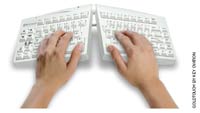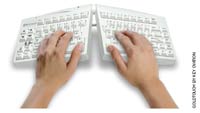
Tactical Tenting
When typing, finding your ‘happy place’ is all in the wrist
 Try this: Stand up straight with your arms at your sides, palms facing legs. Slowly raise your arms from the elbow, letting your wrists relax. Now, without turning your wrists, start “typing.” If you’re doing it right, you should be looking like a nervous pianist mentally prepping for a performance, or perhaps Wing Biddlebaum from Winesburg, Ohio. The point to note, however, is that unless you consciously turned your hands during the raising, they assumed a slight angle, as if ready for a handshake, and in this natural position your palms are not facing straight down.
Try this: Stand up straight with your arms at your sides, palms facing legs. Slowly raise your arms from the elbow, letting your wrists relax. Now, without turning your wrists, start “typing.” If you’re doing it right, you should be looking like a nervous pianist mentally prepping for a performance, or perhaps Wing Biddlebaum from Winesburg, Ohio. The point to note, however, is that unless you consciously turned your hands during the raising, they assumed a slight angle, as if ready for a handshake, and in this natural position your palms are not facing straight down.
Typing, as we know, can be an occupational hazard. The human body is not made to sit and type all day, and those of us who do it anyway must take precautions or suffer the consequences. Measures include maintaining unstrained, neutral, and straight wrist postures at the keyboard and keeping the elbows at a 90-degree angle. This is sometimes easier said than done, unless you have the right equipment.
One Size Doesn’t Fit All
Repetitive strain injuries are rampant in part because people come in all shapes and sizes, and keyboards, for the most part, do not. There usually is a discrepancy between workers’ shoulder width and the width of the keyboard in front of them, so users compensate by either angling their wrists outward during typing, leaning forward with hunched shoulders, or otherwise just having their wrists at odd angles, none of which is good. Even the basic, palms-down hand position necessary for using a standard keyboard can require considerable effort from the smaller muscles in the wrist, which in turn can create tension and strain on the muscles and nerves passing through the carpal tunnel sheath.
According to Christopher Lowe, a certified associate ergonomist, the ideal setup for those who do much typing is to have a keyboard that adjusts to them rather than the other way around. Because Lowe also is VP of sales and marketing for the Goldtouch line of ergonomic products—the premier example of which is the Goldtouch Adjustable Keyboard—it can be fairly said that he has a bias, but because the product’s manufacturer, Austin-based Key Ovation, allowed me to try one out myself—and because I am in fact using it to type this column—I have to admit it’s a bias I share.
“There’s a lot of misinformation about ergonomics and what is ergonomic,” Lowe says. “Our feeling is that if it’s not adjustable, then it’s not ergonomic. If it doesn’t fit you, it’s not providing you any benefit.”
Here’s the Pitch
The standout feature of the Goldtouch keyboard is its patented locking ball and socket latch mechanism, which allows for 0-30 degree adjustability both horizontally (increasing or decreasing “splay”) and vertically (increasing or decreasing the board’s “tenting”). Releasing the latch, located at the top, allows the user to spread the keyboard in or out and bring the middle of it up (like a tent) until it feels right.
“There are no additional accessories to buy to make it adjust,” Lowe says. “It’s simply there in one piece—here’s your keyboard, here’s the latch. Adjust it, find your happy place, lock the latch back in place, and you’re off to the races.”
Well, yes and no. It’s true the board’s adjustability could not be easier, but if you’re not used to typing at an angle—no matter how natural that angle is, and no matter how much pressure on the wrist and arms that angle is relieving—the feel of it can take getting used to.
“The keys are laid out a little bit differently, so there is a learning curve,” Lowe says. “The bottom line is if you’re in pain, you’re going to adapt. A lot of it is psychological, but you get used to where the keys are and to the split layout pretty quickly, and you’ll also find that you’re having less fatigue and less pain pretty quickly—even after the first week.”
The biggest change regarding key placement is that the standard 10-key pad has been removed—or rather, it has been embedded—giving the Goldtouch a much more efficient, compact feel (or, in industry jargon, a much smaller footprint) than a standard keyboard. The idea, Lowe says, is to maximize space and bring the mouse in closer to the keys.
“What we see is that people are straining with their right arm to get to the mouse, and they’re reaching over the 10-key and over the keyboard itself to get all the way out there,” he says. “That’s creating a lot of tension in the neck and shoulder, especially if I’m a petite-framed person. So, just having the small footprint of the keyboard makes a huge difference.”
The keys themselves provide a final ergo feature. Whereas the activation pressure on a standard keyboard is 60 to 80 grams of force, it’s 40 to 45 grams on the Goldtouch. This translates to a satisfyingly soft, if not golden, touch.
This article originally appeared in the December 2008 issue of Occupational Health & Safety.